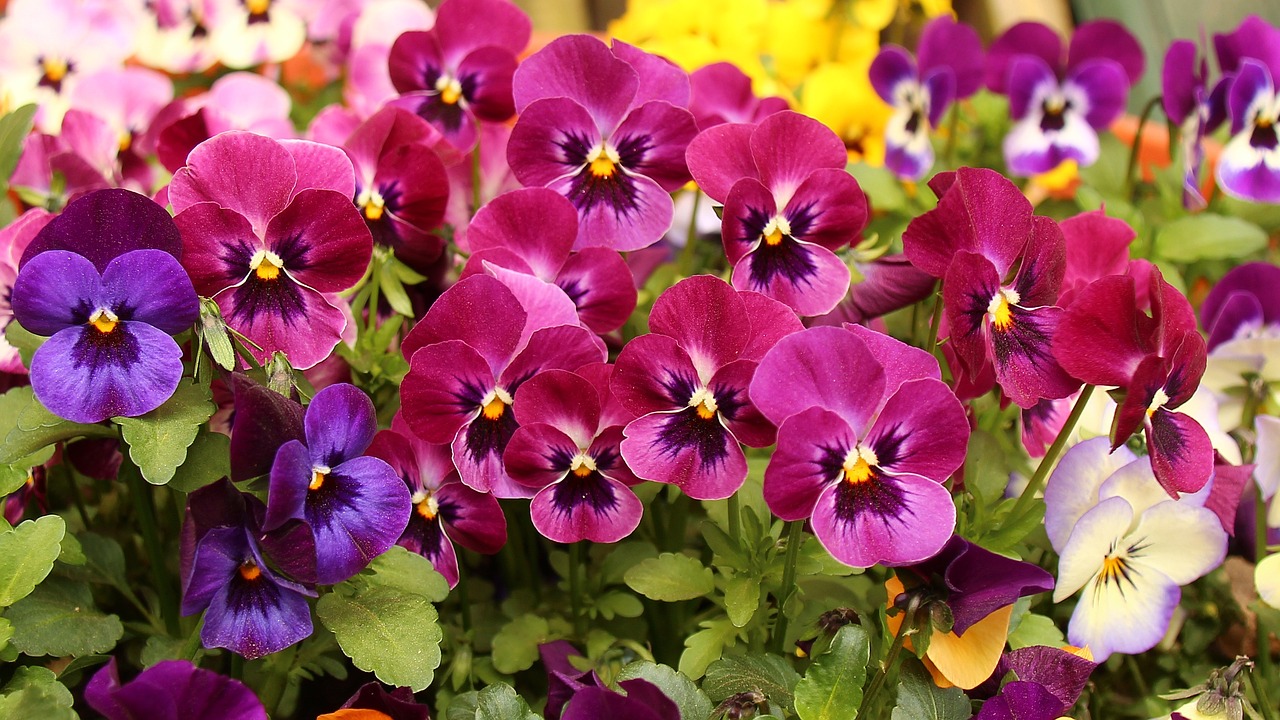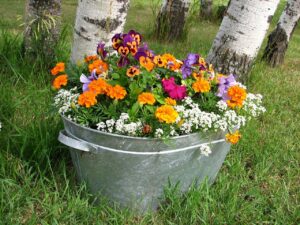Growing Pansies: From Seed to Bloom
Pansies are popular among gardeners for their vibrant colours, delightful fragrance, and versatility. Having seen them flourish in my own garden, I can personally attest to the charm they bring to any outdoor space. In this detailed guide, we’ll cover everything you need to know about how to grow pansies, from planting the seeds to caring for the flowers and employing them as companion plants in your garden.
Pansy Varieties

With a plethora of pansy varieties available, you can find the perfect match for your garden’s aesthetic. From solid colours to intricate patterns, pansy flowers offer endless options to suit your personal style and preferences. Here are some popular varieties:
- Heartseases (Viola tricolor): Although often referred to as wild pansies or Johnny Jump-ups, heartseases are a type of viola. They are smaller than most pansy varieties and feature charming tri-coloured flowers in purple, yellow, and white shades. Despite the slight differences in appearance, heartseases and pansies share similar growing conditions and care requirements, making them excellent companions in the garden.
- Swiss Giant Pansy: Known for their large blooms reaching 3 inches in diameter, Swiss Giant pansies offer a wide range of colours and patterns, including single and bi-coloured flowers.
Swiss Giant Pansies - Horned Pansy (Viola Cornuta): This striking variety, also known as horned violet, is admired for its beautiful petals and contrasting central yellow eye. Though not a true pansy, Viola Cornuta is closely related and adds a dramatic touch to any garden. Its rich coloration creates a bold visual statement, making it a captivating choice for garden enthusiasts seeking an eye-catching alternative to traditional pansies. Plant Viola Cornuta seeds to enjoy these charming flowers in your outdoor space, and experience the unique appeal they bring to your garden.
- Matrix Pansy: Matrix pansies are known for their compact, uniform growth and an impressive array of vibrant colours. This variety is particularly well-suited for container gardening due to its tidy appearance.
- Frizzle Sizzle Pansy: With unique, frilly petals and a range of colourful patterns, Frizzle Sizzle pansies bring a whimsical and playful touch
King Henry Pansy to any garden.
- Inspire Plus Pansy: Inspire Plus pansies boast large, colourful blooms on sturdy, compact plants. This variety is particularly resistant to heat and cold, making them an excellent choice for various climates.
- Cool Wave Pansy: Cool Wave pansies are a trailing variety, perfect for hanging baskets or as a ground cover. They offer an abundance of blooms in various colours and patterns, creating a cascade of colour throughout the season.
How to Grow Pansies from Seed
Growing pansies from seed is a rewarding process that allows you to select from a wide range of pansy varieties. To ensure successful germination, follow these steps:
- Choose a high-quality seed mix and start your seeds indoors about 8-12 weeks before the last expected frost in your region.
- Sow the seeds in seed trays or pots filled with a well-draining, sterile seed-starting mix.
- Keep the soil consistently moist but not waterlogged, and maintain a temperature of 65-70°F (18-21°C) for optimal germination.
- Once the seedlings have developed two sets of true leaves, transplant them into individual pots or directly into the garden.
How to Plant Pansies
Selecting the right location and planting method for your pansies is essential to ensure healthy, vibrant blooms. Follow these steps to ensure your pansies get off to the best possible start:
- Choosing a Location: Choose a location with well-draining soil and partial to full-sun exposure. Pansies thrive in cool, moist conditions and require ample sunlight to produce blooms. Look for a spot that receives at least 4-6 hours of direct sunlight daily.
- Spacing: Space the pansy plants 6-12 inches apart, allowing for ample airflow and room for growth. This spacing will allow the plants to spread out and develop a healthy root system. Overcrowding can lead to poor growth and an increased risk of disease.
- Planting: Plant the pansies at the same depth they were in their pots, and water them well after planting. Dig a hole slightly larger than the root ball and gently place the plant into the hole, making sure the top of the root ball is level with the surrounding soil. Backfill the hole with soil and gently press down around the plant to remove any air pockets. Water the newly planted pansies thoroughly to help settle the soil around the roots.
Pansy Plant Care
Proper care is essential for maintaining healthy pansy flowers and ensuring a long blooming period. By following these guidelines, you can help your pansies thrive and provide continuous color in your garden.
- Watering: Water your pansies regularly, keeping the soil consistently moist but not waterlogged. Overwatering can lead to root rot, while underwatering can cause the plants to wilt and reduce their blooming potential. Be sure to adjust your watering schedule based on the weather conditions, watering more frequently during hot, dry periods, and less frequently during cooler, damp conditions.
- Fertilizing: Fertilize your pansies with a balanced, slow-release fertilizer every 4-6 weeks throughout the growing season. This will provide the necessary nutrients for healthy growth and vibrant blooms. Be sure not to over-fertilize, as this can lead to excessive foliage growth at the expense of flower production.
- Deadheading: Deadhead spent flowers to encourage new blooms and maintain a tidy appearance. Regularly removing the faded flowers prevents the plants from putting energy into seed production, which can reduce the overall blooming period. To deadhead, simply pinch off the spent blooms at the base of the flower stem, taking care not to damage the surrounding foliage.
- Pest and Disease Control: Keep an eye out for common pests like aphids and slugs, as well as diseases such as powdery mildew and downy mildew. Address any issues promptly with the appropriate treatments or organic solutions to maintain your pansy plants’ overall health and vitality.
How to Care for Pansies in Pots
Potted pansies require some additional considerations to ensure they thrive and provide beautiful blooms.
- Select a pot with drainage holes to prevent waterlogged soil.
- Use a high-quality, well-draining potting mix to promote healthy root growth.
- Monitor the moisture levels in the pot, as potted pansies may require more frequent watering than those planted in the ground.
Common Questions Answered
Are Pansies Perennial?
While pansies are often treated as annuals, they are short-lived perennials. In some regions with mild winters, pansies may survive for multiple seasons, providing colourful blooms year after year.
When Do Pansies Bloom?
Pansies typically bloom in the spring and fall, although some varieties may bloom throughout the summer in cooler climates.
How Long Do Pansies Bloom?
With proper care, pansies can continue to bloom for up to four months.
Pansy Companion Plants
Pansies make excellent companion plants, adding a burst of colour to your garden alongside other cool-season flowers and plants. Their versatility makes them a great addition to any garden design, providing visual interest and beneficial relationships with neighbouring plants. Here are some popular pansy companion plants to consider:
- Violas: As close relatives to pansies, violas offer a smaller, more delicate bloom in a wide range of colours. Planting pansies and violas together creates a harmonious blend of texture and colour in your garden.
- Primroses: With their bright, cheerful flowers, primroses make an ideal companion for pansies. Both plants thrive in similar conditions and bloom during the cool seasons, creating a colourful display in the garden.
- Snapdragons: The tall spires of snapdragons contrast beautifully with the low-growing pansies, providing height and visual interest. Their wide range of colours and patterns can complement or contrast with your pansy selection.
- Tulips and Daffodils: Early spring bulbs like tulips and daffodils pair well with pansies, as they all bloom around the same time. Planting pansies around these bulbs creates a colourful ground cover, filling any gaps in the garden and adding an extra layer of interest.
- Ornamental Kale and Cabbage: The unique textures and bold colours of ornamental kale and cabbage make them a striking companion for pansies. Together, they create an eye-catching combination that thrives in the cool seasons.
- Heuchera: Also known as coral bells, heuchera offers attractive foliage in shades of green, purple, and bronze. The contrast between their leaves and the vibrant pansy flowers creates a visually appealing mix in your garden.
- Ivy: As a trailing plant, ivy can be an attractive companion for pansies in container gardens, providing a cascading effect over the edges of pots and planters. This combination creates a lush, full display in your containers.
Conclusion
Learning how to grow pansies and care for them properly will reward you with stunning, long-lasting blooms that add colour and charm to your garden. Whether you’re planting them in pots, as companion plants with beautiful violas, primroses, or snapdragons, or exploring the various pansy varieties such as Swiss Giant or King Henry, these versatile flowers are sure to impress. With proper pansy plant care, you can enjoy these delightful flowers when they bloom in the spring and fall, and even extend their blooming period. So, embark on your gardening journey with pansies, and experience the joy of cultivating these vibrant blooms from seed to flower.







